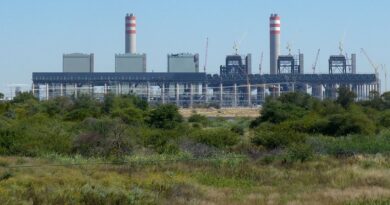Collapsing Eskom and load shedding stages explained
At all times there must be sufficient supply to meet demand, however electricity demand is not constant because of:
- peak periods when demand is higher
- continuous growth in the number of customers requiring electricity services.
- gross mismanagement by Eskom leadership
- and decades of neglect, underinvestment, and corruption by the ANC government
Load shedding is a controlled process that responds to unplanned events in order to protect the electricity power system from a total blackout. While we generally use the word blackout loosely to mean “no lights” in our local area, a country-wide blackout has much more serious consequences. Blackouts occur when there is too much electricity demand and too little supply, bringing the power system into an imbalance and consequently tripping the power system in its entirety.
Load shedding will be used under emergency conditions for limited periods. Eight schedules have been developed based on the level of risk and to ensure that load shedding is applied in a fair and equitable manner:
- Stage 1 allows for up to 1000 MW of the national load to be shed.
- Stage 2 allows for up to 2000 MW of the national load to be shed.
- Stage 3 allows for up to 3000 MW of the national load to be shed.
- Stage 4 allows for up to 4000 MW of the national load to be shed.
- Stage 5 allows for up to 5000 MW of the national load to be shed.
- Stage 6 allows for up to 6000 MW of the national load to be shed.
- Stage 7 allows for up to 7000 MW of the national load to be shed.
- Stage 8 allows for up to 8000 MW of the national load to be shed.
Load shedding in stages 1 to 4 will be implemented in most parts of the country in 2 hour blocks.
However, in Eskom-supplied Johannesburg areas, blocks are 4 hours long. This is to coincide with City Power’s 4 hour schedule.
Each of the time periods has an additional 30 minutes added to allow for switching of networks in a way that will not damage the power system.
Most customers in 2 hour blocks may therefore be without electricity for up to 2.5 hours at a time, while customers in 4 hour blocks may be without electricity for up to 4.5 hours at a time.
Eskom will begin load shedding customers at the start of the period (for example from 06:00), and will have all scheduled customers switched off within the first half hour (that is, by 06:30)
At the end of the two / four hour period, (that is, by 08:00 or 10:00 as applicable), Eskom will start returning power to customers and should have them all back within half an hour (that is, by 08:30 or 10:30).
Customers will experience that the frequency of load shedding (ie the number of scheduled times per day) increases as higher Stages of load shedding are activated.
Also, customers in areas that experience 2 hour blocks in Stages 1 to 4, will find that the length of these blocks is doubled progressively to 4 hours as stages 5 to 8 are activated.
- Stage 1 load shedding means that up to 1000MW of capacity needs to be shed. Consumers can expect to be shed up to 3 times over a four-day period for two hours at a time, or 3 times over an eight-day period for four hours at a time.
- Stage 2 load shedding means that up to 2000MW of capacity needs to be shed. Consumers can expect to be shed up to 6 times over a four-day period for two hours at a time, or 6 times over an eight-day period for four hours at a time.
- Stage 3 load shedding means that up to 3000MW of capacity needs to be shed. Consumers can expect to be shed up to 9 times over a four-day period for two hours at a time, or 9 times over an eight-day period for four hours at a time.
- Stage 4 load shedding means that up to 4000MW of capacity needs to be shed. Consumers can expect to be shed up to 12 times over a four-day period for two hours at a time, or 12 times over an eight-day period for four hours at a time.
- Stage 5 load shedding means that up to 5000MW of capacity needs to be shed. Consumers can expect to be shed up to 12 times over a four-day period: • 9 times for 2 hours • 3 times for 4 hours
- Stage 6 load shedding means that up to 6000MW of capacity needs to be shed. Consumers can expect to be shed up to 12 times over a four-day period: • 6 times for 2 hours • 6 times for 4 hours
- Stage 7 load shedding means that up to 7000MW of capacity needs to be shed. Consumers can expect to be shed up to 12 times over a four-day period: • 3 times for 2 hours • 9 times for 4 hours
- Stage 8 load shedding means that up to 8000MW of capacity needs to be shed. Consumers can expect to be shed up to 12 times over a four-day period for four hours at a time.
If more load needs to be shed than has been scheduled in Stages 1 to 8, then National Control will instruct additional, unscheduled load shedding. This means you may be shed outside of your scheduled times.
The actual stage in use at the time will be displayed on the main Eskom website and on the home page of the Load Shedding Website, as well as on the MyEskom App.
Customers may also choose to use third party Apps which are available in the Apple and Android App Stores. These apps are developed and operated by third parties who have no affiliation with Eskom, however, Eskom freely shares all of the load shedding data available on its website and App with third party providers. Eskom cannot guarantee that these providers are using the latest data, nor that their apps are functional, but experience shows that they provide a useful alternative service.




